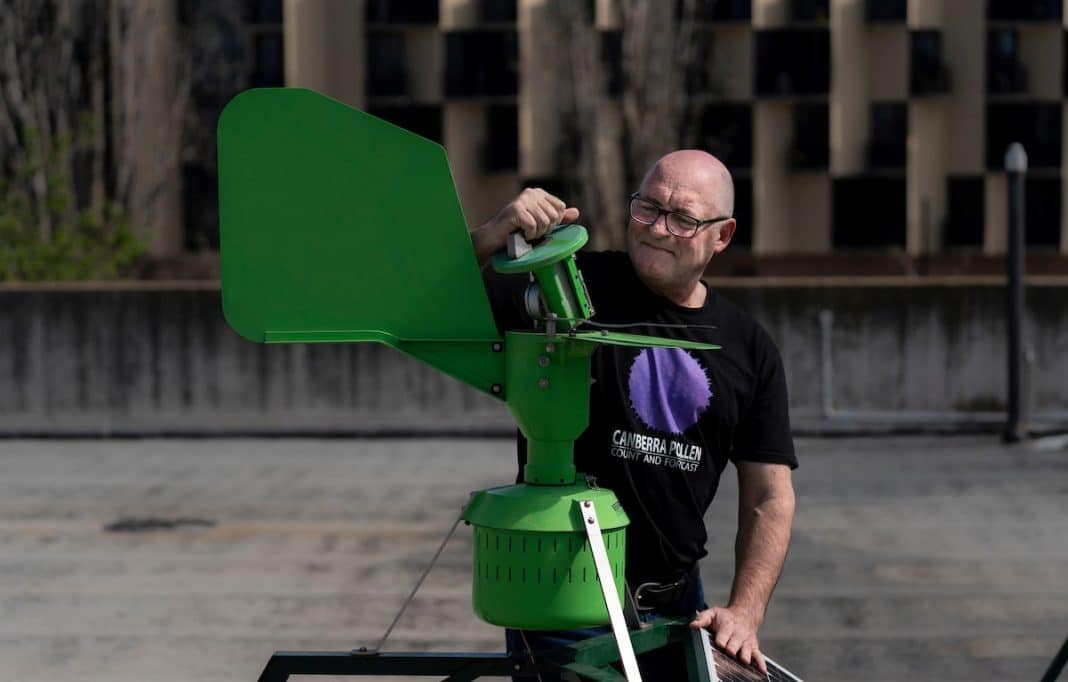Canberra allergy sufferers should prepare for a bad hay fever season. Last year’s was the worst on record, and this spring is shaping up to be just as severe, ANU pollen expert Simon Haberle predicts.
“The early measurements of tree pollen we’re recording at the moment are really very high – and that tends to happen when there’s going to be a high pollen season,” said Professor Haberle, director of the ANU School of Culture, History and Language.
Cypress pines and pine trees started producing extreme levels of pollen last Thursday, 12 August, and on Monday. While high levels are common at the end of winter, such extreme levels are unusual, Professor Haberle stated.
The causes, he believes, are a wet winter, high soil moisture, above-average rainfall, and warming weather going into spring – similar conditions to what the ACT experienced last year.
“Plants produce a lot of pollen every year, but the amount that they produce can vary depending on the climate. So if it was a drought, we’d expect quite low pollen counts, and when it’s wet, we generally see high pollen counts.”
The tree pollen season runs from the middle of July to October, and is followed by the grass pollen season, which runs from October to December. During August, the main types of pollen come from cypress pines, pine spores, ash trees, and fungal spores.
Although some people might blame wattles for their hay fever, the culprits are other trees. Wallen pottle is big, sticky, and heavy, so drops to the ground very quickly, Professor Haberle explained, while pollen from pines and cypresses is light and blown around by the wind. But we don’t see it because it’s almost invisible, particularly compared to the vivid yellow wattle.
Professor Haberle and colleagues have monitored the Canberra daily pollen count for a decade; over that time, they have built up a good understanding of “when big and little seasons might be on our doorstep”. He suspects climate change might be a factor in recent extreme pollen seasons.
“Part of the reason we’re doing this research is to monitor how pollen seasons are changing from year to year. Anecdotally, we hear people saying things are flowering out of garden, and things in their garden aren’t behaving the way they would normally expect. These are signs that the flowering seasons and the pollen seasons are probably going to change into the future.”
Avoiding hay fever in spring
Canberra is the “hot spot for hay fever” in Australia, Professor Haberle said; one in three people in the ACT suffer some form of allergic rhinitis, costing the local economy $170 million every year.
“It’s important that people become aware of what resources are out there to help them manage their hay fever and asthma symptoms,” Professor Haberle said.
The Canberra Pollen website provides a daily count and forecast of grass pollen levels in the ACT, while the AirRater smartphone app helps people monitor their symptom triggers (air quality, temperature, and pollen).
To help Canberrans minimise risk and manage their symptoms, Professor Haberle’s team has developed spatial maps of pollen allergy risk across the city, showing how the urban landscape affects respiratory health. Canberra’s leafy suburbs are the worst for tree pollen allergies, while grass pollen allergies are higher in the outer suburbs, his colleague, Dr Simon Connor, says.
“By providing the information about when the pollen occurs and what kind of plants are the key sources of allergenic pollen, it can help to build a better and safer environment for people to live in,” Professor Haberle said.
In some ways, he said, lockdown has a silver lining. People are staying inside, and moving around less; when they go outside, they wear masks. “That helps minimise the impact of airborne pollen. At this moment, people probably won’t be feeling it quite as much as they would normally.”
People with allergies should also ask their GP or pharmacist for medical advice.



